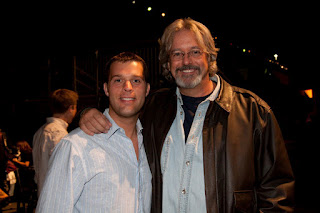By PAUL VITELLO
Don Grady, who played Chip and Ernie’s wholesome, heartthrob big brother Robbie on the long-running television sitcom “My Three Sons,” died on Wednesday at his home in Thousand Oaks, Calif. He was 68.
 Don Grady, center, surrounded by fellow “My Three Sons” cast members: clockwise from top right, William Demarest, Barry Livingston, Stanley Livingston and Fred MacMurray.
Don Grady, center, surrounded by fellow “My Three Sons” cast members: clockwise from top right, William Demarest, Barry Livingston, Stanley Livingston and Fred MacMurray.A family spokesman said the cause was cancer.
Mr. Grady, a versatile musician and singer who got his start in television as a Mouseketeer on “The Mickey Mouse Club,” considered music his vocation and his acting career something of an accident. At 14, he was an aspiring musician in high school who played ukulele, drums, accordion and clarinet while acting on the side when he was called to audition for the part of Robbie Douglas, one of three sons of the wistful, pipe-smoking widower Steve Douglas, played by Fred MacMurray.
The producers had already cast another actor. “But, for reasons I never found out, they needed to replace him,” Mr. Grady wrote in the forward to “Fred MacMurray,” a 2007 biography by Charles Tranberg. “I was summoned to a hastily held audition at noon, and by 3 p.m. I was cast as the new Robbie. My acting abilities probably helped, but I still believe the reason I got the part was because the cleft in my chin looked like Fred’s.”
The producers had already cast another actor. “But, for reasons I never found out, they needed to replace him,” Mr. Grady wrote in the forward to “Fred MacMurray,” a 2007 biography by Charles Tranberg. “I was summoned to a hastily held audition at noon, and by 3 p.m. I was cast as the new Robbie. My acting abilities probably helped, but I still believe the reason I got the part was because the cleft in my chin looked like Fred’s.”
He played Robbie throughout the life of the show, more than 300 episodes from 1960 to 1972, although his place in the fictional family hierarchy shifted slightly over time. He was Mr. Douglas’s middle son in the first few years, until the role of the original older brother, Mike (Tim Considine), was written out of the script and a new brother — the adopted son, Ernie (Barry Livingston) — was written in. Chip Douglas (Stanley Livingston, Barry’s older brother in real life) took Robbie’s place in the middle.
Mr. Grady’s Robbie was always the coolest son. He was the teen idol of the cast, his face having been featured on the cover of teen magazines since his days as a Mouseketeer. Like Ricky Nelson of “Ozzie and Harriet,” Robbie sang in a band, and it performed on the show.
As the eldest son for most of the show’s run, Mr. Grady was the family’s earnest grown-up-in-training and the most frequent recipient of the fatherly advice that capped almost every episode.

“Now, Rob, do you really think that’s the right thing to do?” Mr. MacMurray said in the 13th episode of Season Four, poking the air with his pipe.“Well, no, Dad,” Robbie answered. “Not when you put it like that.”
Don Louis Agrati was born in San Diego on June 8, 1944. His parents divorced when he was in his teens, and his mother, Mary, became a theatrical agent. One of his two sisters, the actress Lani O’Grady, died in 2001. He is survived by his wife, Ginny, his two children, Joey and Tessa, his mother, and another sister, Marilou Reichel.
As the eldest son for most of the show’s run, Mr. Grady was the family’s earnest grown-up-in-training and the most frequent recipient of the fatherly advice that capped almost every episode.

“Now, Rob, do you really think that’s the right thing to do?” Mr. MacMurray said in the 13th episode of Season Four, poking the air with his pipe.“Well, no, Dad,” Robbie answered. “Not when you put it like that.”
Don Louis Agrati was born in San Diego on June 8, 1944. His parents divorced when he was in his teens, and his mother, Mary, became a theatrical agent. One of his two sisters, the actress Lani O’Grady, died in 2001. He is survived by his wife, Ginny, his two children, Joey and Tessa, his mother, and another sister, Marilou Reichel.
 Mr. Grady appeared in other shows besides “My Three Sons,” including “The Rifleman” and “Wagon Train.” But he focused mainly on his music after the series ended, forming a pop singing group, “The Yellow Balloon,” which recorded a song of the same name in 1967. It was the band’s only hit, reaching No. 25 on the Billboard pop charts.
Mr. Grady appeared in other shows besides “My Three Sons,” including “The Rifleman” and “Wagon Train.” But he focused mainly on his music after the series ended, forming a pop singing group, “The Yellow Balloon,” which recorded a song of the same name in 1967. It was the band’s only hit, reaching No. 25 on the Billboard pop charts.He later composed music for television, theater and films, including the theme song to Phil Donahue’s talk show, songs for the TV series “The Kid-a-Littles” and the 1985 film “Girls Just Want to Have Fun.” He was a co-writer of “Keep the Dream Alive,” which was recorded by Herbie Hancock, Della Reese and others for the Jazz to End Hunger project.

Stanley Livingston said in an interview on Thursday that Mr. Grady was a lot like the character he played on “My Three Sons.”
“He had a lot of charm,” said Mr. Livingston. “He was a good guy to be with. People loved him. He really was a wonderful big brother.”
For more information visit: http://www.dongrady.com


























